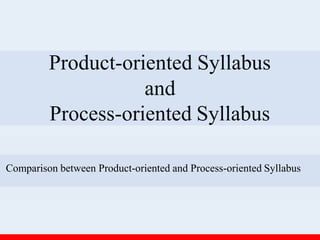
Product oriented syllabus
- 1. Product-oriented Syllabus and Process-oriented Syllabus Comparison between Product-oriented and Process-oriented Syllabus
- 2. Product oriented Syllabus “Product oriented syllabuses are those in which the focus is on the knowledge and skills which learners should gain as result of instruction.” – Nunan (1988) — Product-oriented syllabus focuses on outcomes (what is learnt at the end of a learning session) — Focuses on things learnt at the end of a learning process (things that are instructed by teachers/instructors)
- 3. Example: In a language classroom- students work with Grammatical structure in their English course and show their progress at the end of the session by attending tests based on the provided grammatical items.
- 4. Process oriented Syllabus —A process oriented syllabus focuses on the skills and processes involved in learning language. —It focuses on the processes of learning. —Process-oriented syllabuses are developed as a result of a sense of failure in product-oriented syllabuses to enhance communicative language skills.
- 5. Example: Rather focusing on the features of the products of writing, such as letters, compositions, notes, reports etc, a process-writing syllabus would focus on the processes writers use to complete their tasks, such as: —collecting information, —organizing ideas, —drafting and revising,
- 6. Comparison between Product oriented and Process oriented Syllabus Product oriented —Focus is on knowledge and skills —Skills that learnt at the end of learning session —Focuses on completed acts of communication (outputs) —Emphasis on the output —Concentration is towards the goal Process oriented —Focuses on the process of learning —Skills that involved in language learning process —Emphasis is on the process —Series of action is important Every syllabus is both product-oriented as well as process- oriented. But the difference is created because of the emphasis on any one of them while designing a syllabus. Many argue that a successful syllabus must be combination of both processes and outcomes. Analytic and synthetic syllabus. Grammatical syllabus, Functional- notional syllabus. AnalyticSyllabus Procedural syllabus, Task based syllabus, Content syllabus, Natural- approach syllabus
- 7. Comparison continues Product oriented Process oriented —Grammatical syllabus: I. Based on the structure of a language II. Learners learn grammatical structures in a sequence that reflects their complexity III. Does not encourage the use of grammatical structures in real communication IV. Leading to many artificial contexts for practice V. Inability to transfer learning to real communication —Task based Syllabus I. An activity or action carried out as the result of processing pr understanding language II. Based on task-based learning III. learners carry out tasks such as solving a problem or planningan activity IV. Involve learner contributions and promote language practice V. The language learnt comes out of the linguistic demands of the activity VI. Example: drawing a map while listening to an instruction, filling out a form, performing a command , etc.
- 8. —Functional-notional syllabus I. Function: communicative purpose for which we use language. II. Notion: conceptual meanings expressed through language.(objects, entities, logical relationships, etc.) III. In this syllabus language contents is arranged according to learners communicational needs. IV. It sets realistic learning tasks V. It provides for the teaching of real world language VI. It provides for the widespread promotion of foreign language courses —Content based syllabus: I. An approach to language teaching in which the focus is on the development of language through classroom activities II. Designed to promote cognitive skills III. Involves the integration of subject matter(what to talk about) and linguistic matter (how to talk about) IV. Theme based teaching V. Language class activities are specific to the subject matter being taught VI. Teaching elements/course is structured around certain themes VII.Such as: Cooperative learning, task base/experiential learning, project work, whole language approach Product oriented Process oriented
- 9. Process oriented —Natural approach syllabus I. Comprehensively described by Krashen and Terrell (1983) II. Principles are based on experimental research such as: III. The goal is communication skills IV. Comprehension precedes production V. Learners are not forced to respond; production emerges VI. Central activities promote subconscious acquisition of language, rather than conscious learning. —The natural approach is designed to develop basic personal communication skills- both oral and written and was not developed specifically to teach learning skills Product oriented — Analytic Syllabus I. Organized in terms of the purposes for which the learner is learning the language. II. Syllabus is not designed for analyzing the grammatical structure of the language. III. It is designed for the communicative use/purpose of the language. IV. The language and contents are drawn from the input. V. Language contents are selected and graded primarily according to the learner’s need (real world communicative task)
- 10. Learners working with a product-oriented syllabus can be supportedwith other approaches and techniques. For example: —teachers can incorporate elements of learner training and developmentfrom learner-centered syllabi or — Use activities from process-oriented syllabi such as task-basedlearning. —working on the language processes ( writingspeaking) is hard work for learners. It involves thinking, organizing and planning. —If time well-invested in skills- that will enable the learner to become an autonomous writerspeaker. Conclusion
- 11. End of Slides